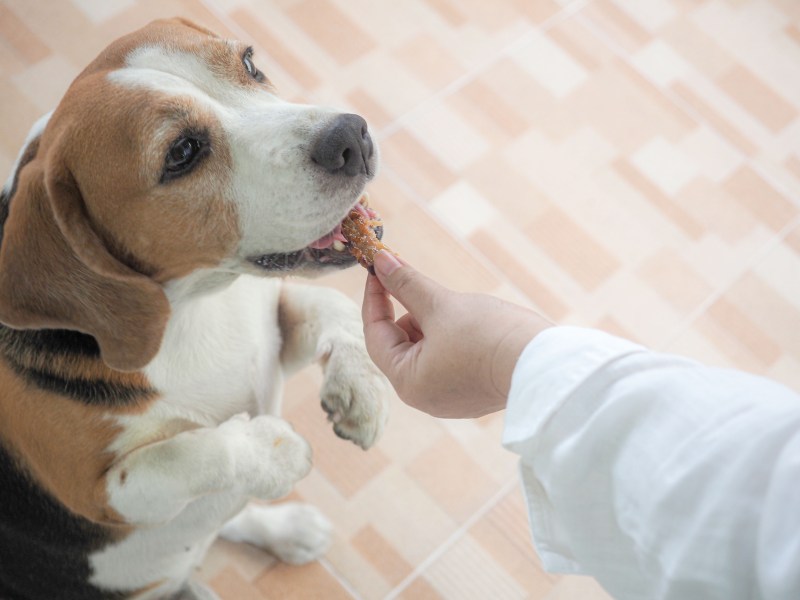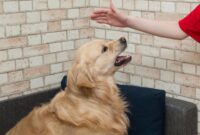Positive Reinforcement Dog Training – For all pet parents who share their lives with furry companions, building a strong and loving bond with a dog is a rewarding experience. Positive reinforcement is one of the most impactful and fun ways to achieve this goal.
Positive reinforcement is more than just a training technique; is a powerful tool that can strengthen the unique bond between you and your dog.
Positive Reinforcement Dog Training

So grab some treats, get ready for some tail-wagging fun, and discover how positive reinforcement can create an unbreakable bond between you and your beloved pup!
Positive Reinforcement Training For Dogs: Vet Verified Behavioral Science & Tips
Positive reinforcement dog training is very effective because it uses the power of rewards to shape and reinforce desired behaviors in your furry friend.
This method focuses on what your dog does well and encourages him to repeat those activities by offering something he appreciates, such as a treat, praise, or play.
Just like us, dogs like to be rewarded for their efforts. Positive reinforcement helps dogs understand that good behaviors lead to positive outcomes.
Positive reinforcement training can work for most dogs, regardless of age, breed, or temperament. It adapts to your dog’s needs and helps it reach its full potential.
R Only Training For Dogs?
You create a loving and trusting relationship with your dog by consistently using positive reinforcement. They begin to associate you with all the good things in life, making them want to please and be around you.
Unlike negative or punishment-based methods, positive reinforcement training does not cause fear or anxiety in dogs. Instead, it creates a stress-free environment, making learning fun for your pet.
Positive reinforcement relies on clear verbal cues, body language, and rewards to keep you and your dog on the same page during training sessions.

Dogs become active participants in the learning process. They start thinking and figuring out how to get rewards by demonstrating the desired behavior.
Navigating The Matrix Of Dog Training Approaches
Consistency and balance are key aspects of positive reinforcement training that can significantly impact your dog’s learning process.
Dogs thrive on routine and repetition. Consistency means using the same verbal cues, hand signals, and rewards every time you train your dog. This helps them understand what is expected of them and minimizes confusion.
While positive reinforcement is a great method, it is important to balance rewards and set boundaries. Dogs need to know when they are doing something wrong, but it is equally important to reward them for good behavior.
Consistency and balance provide accurate feedback to your dog. They know when they have done something right and can expect a reward, but they also learn when certain behaviors are unacceptable.
The Power Of Positive Reinforcement: Training Your Pet With Kindness
Consistent training can provide your dog with mental clarity, making it easier for him to learn and remember desired behaviors. Consistency ensures that your pet is always on the same page as you.
A balanced approach to positive reinforcement helps build trust between you and your dog. They understand your expectations and feel safe knowing that you will guide them in the right direction.
Consistency and balance allow you to adapt the training method to different situations. A consistent and balanced approach is important, whether it’s crate training, teaching new tricks, or addressing specific behavioral issues.

Operant conditioning is a fundamental concept in dog training that forms the basis of positive reinforcement techniques. This approach focuses on shaping your dog’s behavior through consequences.
Some Thoughts On Dog And Pet Training
Operant conditioning is based on the idea that a dog’s behavior is influenced by the consequences it experiences. Behaviors that lead to positive outcomes are more likely to be repeated.
Positive reinforcement involves rewarding your dog when it exhibits desired behavior. This can be achieved through treats, verbal praise, toys, or any other reward that your dog likes. The key is to reinforce the reward when the desired behavior occurs.
Negative reinforcement does not mean punishment. Instead, it aims to remove the unpleasant stimulus once the dog performs the desired behavior. For example, loosening the leash when your dog stops pulling will encourage him to walk properly.
While positive reinforcement encourages desired behaviors, punishment aims to discourage undesirable behaviors. However, it is important to use punishment sparingly and as a last resort, as it can cause fear and anxiety in the dog.
Why Positive Reinforcement Is Key For Proper Training
Consistency in the use of consequences is necessary for operant conditioning to work effectively. Your dog should understand that the same behavior will consistently lead to the same result.
As a pet parent, it is important to keep a close eye on your dog’s behavior and provide rewards or consequences at the right time. Timing is crucial to successfully reinforcing or discouraging behavior.
Operant conditioning has four quadrants, each representing a different way of influencing behavior. Understanding these quadrants is crucial to effective dog training. These are the four quadrants of operant conditioning:

It is important to note that positive and negative reinforcement are the main goals of positive reinforcement training methods. These quadrants emphasize encouraging your dog’s desired behaviors and creating a positive learning experience for your dog. On the other hand, positive and negative punishments should be used with caution because they can lead to stress and anxiety if used incorrectly.
How To Stop Dog Nipping Using Positive Reinforcement: Dog Gone Problems
Positive reinforcement training is a very effective method of encouraging desired behaviors in dogs while strengthening the bond between pet parents and their furry companions. Here’s how positive reinforcement works to promote and reinforce good behaviors:
In summary, positive reinforcement training is a humane and effective method that encourages desired behaviors in dogs. By using rewards and positive experiences, you can create a happy and cooperative learning environment for your pet, which will ultimately result in a well-behaved and well-bonded canine companion.
Positive reinforcement in dog training is not just a theoretical concept; is a practical and effective approach that works wonders in real training situations. Here’s how positive reinforcement comes into play when training your dog:
Positive reinforcement is a practical and effective method in real-world dog training scenarios. This means rewarding desired behaviors with immediate feedback, consistency and clear communication, which ultimately leads to the creation of a well-behaved and happy canine companion.
Positive Reinforcement In Training Dogs: Top Tips
Positive reinforcement is a versatile method used in a variety of dog training scenarios. Here are four examples of the effective use of positive reinforcement:
By using positive reinforcement in these examples, you are not only teaching your dog the desired behaviors, but also creating a positive and enjoyable training experience for him.
Positive reinforcement involves rewarding your dog with things it values to encourage desired behavior. Different dogs have different preferences, so it’s important to find a reward that works best for your furry friend. Here are some types of rewards commonly used for positive reinforcement:

It’s important to experiment with different types of rewards to find what motivates your dog the most. Some dogs may be highly motivated to eat, while others may prefer play or affection. By using rewards that truly resonate with your dog, you will make positive reinforcement training more effective and enjoyable for both of you.
Positive Reinforcement Vs. Balanced Training: What Training Methods Are Best For My Dog?
Positive reinforcement training isn’t just about teaching your dog new tricks and behaviors; it also plays an important role in strengthening the bond between dogs and their owners.
Positive reinforcement methods build trust and respect between you and your dog. Your pet learns that you provide rewards and positive experiences, so they are more willing to listen to your instructions.
During training sessions, you and your dog communicate through verbal signals, body language, and rewards. This clear communication improves mutual understanding and creates a stronger connection.
Positive reinforcement training will be fun for both you and your dog. It turns exercise into a fun and rewarding activity, reinforcing the belief that spending time together is a positive experience.
Why I Decided To Go With Balanced Dog Training
When you use positive reinforcement, your dog will become an active participant in its own learning process. They learn to think and solve problems, deepening their bond with you as they rely on your guidance.
Positive reinforcement training methods avoid the use of punishment, reducing the dog’s fear and anxiety during training. This creates a stress-free environment where they can develop and learn.
With positive reinforcement, you adapt to your dog’s body language, signals and needs. This increased awareness helps you respond more effectively to their emotional and physical well-being. It improves trust, communication and mutual pleasure, making your relationship even more satisfying.

Incorporating positive reinforcement into your daily interactions with your dog is a great way to reinforce good behavior and build a strong bond.
Training — Yourdogwins
Incorporate verbal cues such as “sit,” “stay,” and “nice boy/girl” into your daily conversations with your dog. Consistently reward them with praise when they respond correctly to these signals.
Pay attention to times when your dog displays desired behaviors on its own, such as being quiet, lying down, or barking excessively. Immediately praise and reward these spontaneous good behaviors to encourage them.
Use positive reinforcement to reinforce mealtime behavior. Ask your dog to sit or stay before you put away the food bowl. If they follow suit, reward them with a meal.
Encourage your dog to walk off-leash by rewarding him with treats or praise when he walks nicely by your side. If he pulls on the leash, stop and wait for him to come back to you before continuing your walk.
The First Rule Of Dog Training: Positive Reinforcement With Healthy Treats
Teach your dog to greet people and other dogs calmly. Reward them when they approach with relaxed body language rather than jumping or lunging.
Incorporate positive reinforcement into interactive play. Use toys to engage your dog in games such as fetch or tug-of-war, and reward him with play and treats.
When you spend time with your dog

Positive reinforcement dog training books, positive reinforcement dog training techniques, positive reinforcement dog potty training, dog training methods positive reinforcement, reactive dog training positive reinforcement, positive reinforcement dog training aggression, puppy training positive reinforcement, positive reinforcement horse training, positive reinforcement leash training, positive reinforcement dog training certification, dog training positive reinforcement, positive reinforcement training
- How to maintain a clean pet home: Tips and Tricks for a Fresh and Healthy Environment - December 23, 2024
- DIY pet-friendly home projects: Creating a Happy Space for Your Furry Friends - December 22, 2024
- Pet-friendly storage ideas for homes: Maximizing Space for Pets and Owners - December 20, 2024




